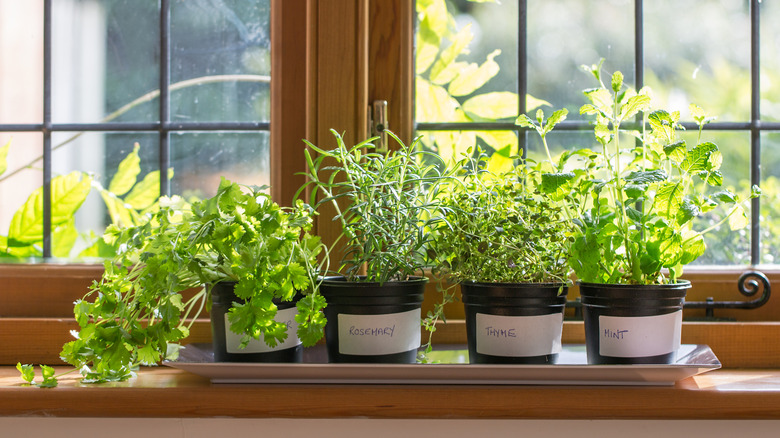How To Turn A Teapot Into The Cutest Indoor Planter
If you've been having trouble finding the perfect planter for your kitchen, you may want to consider an affordable, unique option that can expand your options. Transforming a teapot that you've thrifted into a cute indoor planter is possibly one of the easiest kitchen decor hacks that will set your workspace apart from any other.
First, you'll need the right kind of teapot. Metal and glass won't work for this, so instead look for either clay or ceramic. Next, submerge it in water and allow it to soak for a second or two; then, take a nail and hammer it directly through the center of its bottom. Normally, your pot would shatter with the force, but thanks to a neat little physics trick called the Rehbinder Effect, the nail should cleanly drive through the teapot's material, creating a neat hole. Line the interior of the pot with a coffee filter to prevent soil loss, and you're ready to add a plant!
You don't need a particularly fancy or well-made teapot, either. Feel free to run by a thrift store and grab one with a design you like, giving the retro kitchen item a trendy return. Just be sure to pick one with a wide enough opening to fit your plant and a round enough body to hold plenty of soil. Once you've done all that, you should be able to grow any small plant from a succulent to useful kitchen herbs with little effort.
What kind of plants to put in your teapot planter
The key to picking the right plant for your new pot is to find one that doesn't mind being a bit crowded and doesn't need an expansive root system. While you won't be able to grow vegetables, even a lone tomato plant, you still have plenty of options — whether you want aesthetics or function.
Mint is perfect for beginner gardeners to grow and flourishes without much attention. Offering luxurious scents, utility in recipes, and draping over the sides of the teapot, it's a great choice for both form and function. Basil also does great in pots, though it only grows as large as its root system. Don't expect a huge bush on your counter if you grow one in a teapot, but a single plant should produce enough leaves, especially if you harvest it regularly. Ultimately, just about any herb you'd add to pasta salad is a solid choice so long as you don't expect them to grow too large.
For flowers, lavender is a great choice because its varieties typically have shallow root systems. Much like basil, it grows larger the more soil it has, but thrives well in confined spaces. African violets are a particularly good choice for a teapot planter because they hate getting water on their leaves. However, the tea spout makes avoiding this easy, providing convenient ingress for you to water it directly from the sink.


